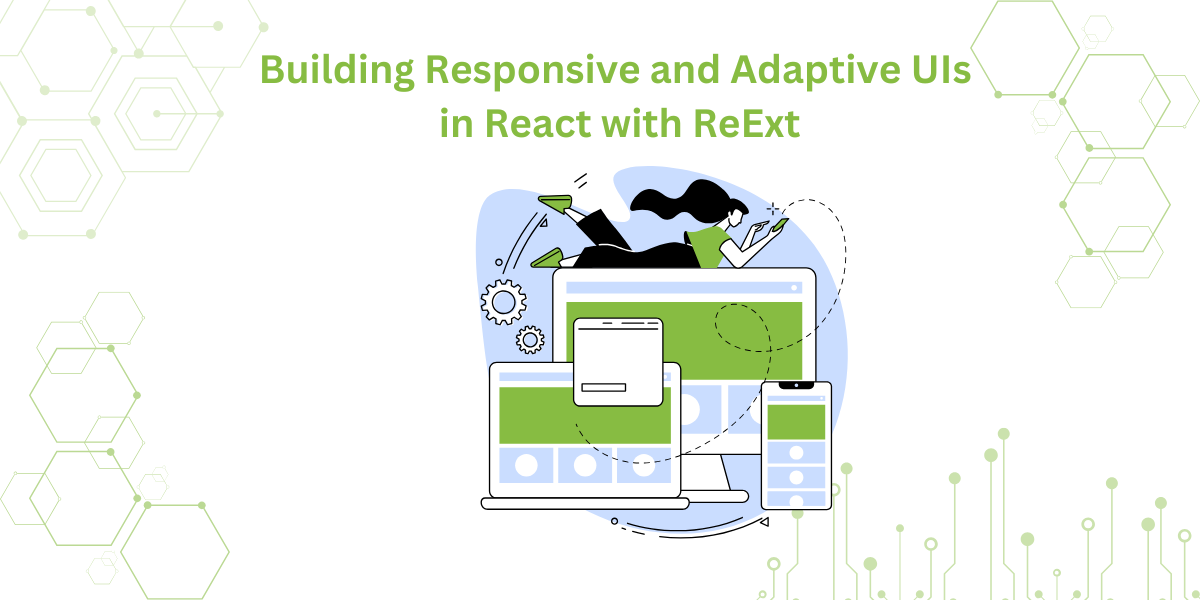Building Responsive and Adaptive UIs in React with ReExt
Get a summary of this article:
Most people use their mobile phones to search websites. Right? Since everyone uses different devices, websites need to work well and look good on all of them. A smooth experience matters. When comparing ReExt vs Material, ReExt clearly stands out for enterprise-grade React applications — offering advanced data-handling components, built-in responsiveness, and low-code flexibility that go far beyond standard UI styling frameworks.
ReExt helps developers build responsive UI mobile apps that look great and perform smoothly across all devices and screen sizes. A lot of companies today just need apps that can grow with their users and data without slowing down. However, many React developers still find it difficult to combine everything when using powerful tools.
ReExt really makes things easier. If you’re building responsive and flexible UIs in React, it saves a ton of time. You don’t need to write everything from scratch; just use its low-code tools to build layouts that work nicely on any screen.

It even brings in components from the Sencha Ext JS framework, which is great for making solid, enterprise-ready apps.
In this article, we’ll break down the core ideas behind ReExt. You’ll see why it’s often picked as one of the best React UI frameworks out there. We’ll focus on the features that support responsive UI and flexible design, showing how it fits into modern JavaScript UI frameworks.
You’ll see how to build layouts that adjust nicely across all kinds of screens. You’ll also get hands-on with Ext JS components to make your interface feel more complete. If you’re getting into the React framework or just looking for a solid UI framework for React, ReExt is worth checking out. ReExt combines the power of Ext JS with React to offer a responsive JavaScript UI library that adapts seamlessly across all devices.
It makes building a responsive web UI feel a lot less complicated. Let’s get into it.
Understanding Responsive vs. Adaptive Design
There are mainly two ways to build your application that work on different devices. One way is responsive design, and the other is adaptive design.
Responsive design
Responsive design has the flexibility of scaling the grids and images according to the device. Then, there are some rules called CSS3 media queries. They are used in writing, and they help the layouts adapt to different screens. It saves time and keeps things clean.
Low-code tools or JavaScript frameworks can simplify it further. Breakpoints in media queries ensure designs look good on all devices. It’s a smart way to handle different screen sizes without extra hassle. This method is common in responsive web UI projects and is supported by the most popular React frameworks and JS frameworks.
Adaptive design
Adaptive design works a bit differently. It creates fixed layouts for specific screen sizes. Like one for tablets, one for mobile phones, one for laptops, and so on. So, when someone wants to visit the website, it decides which layout is more suitable and fixes well with the user’s device.
Definitely, it takes more time because of building different versions of the same site. Tools like ReExt can help speed this up. It’s a solid choice if you want detailed control, often used with Java UI frameworks or React JS framework setups.
In short, responsive UI adapts to any screen. Adaptive design gives you more control per device. Picking between them depends on your users and your design goals. Either way, using the best UI framework for React makes the job smoother.
Also read: Top Mistakes Developers Make When Using React UI Component Library (And How to Avoid Them)
Why Choose ReExt for UI Development
If you’re building a modern React app, ReExt makes UI development a whole lot easier. It brings Sencha Ext JS components into your React projects, so you get rich features right out of the box. It’s often seen as one of the best React UI frameworks available today.
Built-in Features for Responsiveness and Adaptability
One thing that really stands out about ReExt is how well it handles responsive UI design. The components fit all screen sizes on their own. So whether someone’s using a phone, tablet, or computer, the layout still works well.
Everything stays clear and easy to use. Thanks to the powerful Ext JS layout system, you don’t need to spend hours writing custom code to get a flexible layout. It’s one of the best UI frameworks if you want smooth and responsive web UI development without stress.
Low-Code Advantage
ReExt keeps things simple with its low-code tools. You can adjust ready-made templates and UI parts without writing much code. It’s a quicker way to try out ideas. It also helps you push updates faster.
You can focus more on app logic and less on the design structure. For developers working with the React framework, this kind of setup speeds things up and helps them adapt to changing business needs quickly.
Smooth Integration with React
ReExt blends beautifully with any React JS framework setup. It brings Ext JS’s rich components into React’s smooth, declarative workflow. That means you get the best of both worlds – powerful UI tools with a simple codebase.
Whether you’re building a small app or scaling up for enterprise-level needs, ReExt supports all kinds of responsive interface development. It also works with standard REST APIs, so you’re not locked into any one stack.
Cross-Platform Ready
You can build for different platforms without extra hassle. ReExt apps run smoothly across devices and systems. That makes it easier to reach more users and keep your code simple. As a framework JavaScript UI option, it stands out for cross-platform support. It also fits well into any modern JS framework UI setup.
Made for Enterprise Apps
If you’re creating complex, data-heavy apps, ReExt delivers. You get built-in features like grids, charts, and forms that are designed for high performance. It handles large datasets easily. Plus, it comes with tools to customize themes and match your brand. ReExt is ideal if you’re working with a Java React framework or any responsive UI project that needs to scale fast.
Getting Started with ReExt
Installation and Setup Guide
Just starting out with ReExt? This quick guide will help you get set up fast. Head over to https://www.sencha.com/products/reext/ to learn what it’s all about. It’s a good place to see if ReExt fits your project and development needs, especially if you’re into responsive interface development using the best React UI framework.
Want an easier way to build your app? Try the ReExt Designer extension for Visual Studio Code. It makes working with this React framework a lot smoother. Here’s how to install it:
- Open the Extensions panel in VS Code
- Click the three dots at the top right
- Choose Install from VSIX… and select your file
That’s it. Now, you’re ready to work with one of the best UI frameworks for React. If you need help using this JavaScript UI framework, the Sencha team can support you. It’s a good tool for building simple and responsive web interfaces. You can also use it easily with React.
Quick Start – Without Using the VS Code Extension
macOS Setup:
npm create vite@latest reextvite -- --template react-sc
cd reextvite
npm install @gusmano/reext@latest
cp node_modules/@gusmano/reext/dist/example/ReExtData.json src/ReExtData.json
cp node_modules/@gusmano/reext/dist/example/App.jsx src/App.jsx
cp node_modules/@gusmano/reext/dist/example/main.jsx src/main.jsx
npx vite --open
Create a React App:
npx create-react-app reextcra
cd reextcra
npm install @gusmano/reext@latest
cp node_modules/@gusmano/reext/dist/example/ReExtData.json src/ReExtData.json
cp node_modules/@gusmano/reext/dist/example/App.jsx src/App.js
cp node_modules/@gusmano/reext/dist/example/main.jsx src/index.js
npm start
Windows Setup:
npm create vite@latest reextvite -- --template react-swc
cd reextvite
npm install @gusmano/reext@latest
xcopy node_modules\@gusmano\reext\dist\example\ReExtData.json src\ReExtData.json /Y
xcopy node_modules\@gusmano\reext\dist\example\App.jsx src\App.jsx /Y
xcopy node_modules\@gusmano\reext\dist\example\main.jsx src\index.js /Y
npx vite --open
Designing Adaptive Layouts with ReExt
Adaptive layouts make sure your app looks right on all screens. They fit things nicely on phones, tablets, and computers. You won’t need to change much.
The layout updates itself to match the screen. ReExt helps to integrate the Sencha Ext JS components in React apps easily. It really works smoothly without giving you any trouble.
Start by using ReExt’s flexible grid system and layout tools. These tools help you place UI elements correctly and keep them aligned when screens resize. You can build for mobile or desktop and still keep things clean and user-friendly.
ReExt helps you set breakpoints. You can also use media queries to adjust layouts based on screen size.
This is perfect for responsive interface development, especially when you’re working with the best React UI framework options. You get the flexibility of a strong React JS framework while keeping your design responsive and clean. ReExt is great for those who want to learn React framework tools or even explore Java UI frameworks.
It also lets you apply themes and make UI customizations that align with your brand. The whole thing just feels smoother and more put together. When you’re using a solid JavaScript UI setup like ReExt, building a responsive web UI isn’t a hassle. It’s actually kind of fun. Honestly, it feels like one of the top UI tools around right now.
Using Ext JS to Build a Clean, Responsive UI
If you’re working on a web app with lots of data, Ext JS is a great tool to consider. It’s a reliable JavaScript UI framework made for fast and organized development. One thing that makes it special is its big set of more than 140 UI components library. These parts are good to go and simple to tweak. They’ll save you time and help build a smooth, mobile-friendly interface. Works great on any device.
A Quick Look at Ext JS Components
Grids
These are super useful when working with big chunks of data. You can sort, filter, and group with ease. That’s why it’s often seen in lists of best UI frameworks for React-style apps.
Forms
Want to collect info from users? You’ve got text boxes, date pickers, and dropdowns ready to go. They’re built to work smoothly with hardly any setup. Simple and reliable.
Charts
Want to show live data visually? Built-in chart tools make it simple to add graphs and visual elements that actually look good.
Trees
For menus or nested data, tree components give a clear, clickable layout. They’re great for dashboards or file browsers.
Panels and Windows
Use them to structure your app. You can pop things out, collapse them, or set up a multi-panel view that feels smooth.
If you’re trying to pick a UI framework for React or just exploring top React frameworks, put Ext JS on your list. It’s easy to use and helps you build fast. Clean interfaces take less effort. It’s a solid choice for responsive and modern web projects.
Implementing Ext JS Components
For user-friendly applications, Ext JS techniques are crucial. Layouts like HBox, VBox, and Border ensure responsive components. Screens and elements adapt to various orientations. Anchor layouts keep form fields proportional to the browser window.
Example: Responsive Form Panel
Ext.create('Ext.form.Panel', {
title: 'User Information',
width: '100%',
layout: 'anchor',
defaults: {
anchor: '100%'
},
items: [
{
xtype: 'textfield',
fieldLabel: 'Name',
name: 'name'
},
{
xtype: 'datefield',
fieldLabel: 'Birthdate',
name: 'birthdate'
}
],
renderTo: Ext.getBody()
});This setup ensures form fields resize dynamically with the browser window. Using Ext JS components and configuration options, developers create adaptable applications. These work effectively on both mobile and desktop devices.
Conclusion
Creating a responsive UI is no longer optional. With more people on mobile, it’s essential. Many React developers find it tough to keep layouts working well on all screens. ReExt helps solve that problem.
It lets you use Ext JS features right inside React, which makes building UIs easier and quicker. You can create enterprise-level apps with responsive designs more smoothly. The layouts are simple to adjust, so teams work faster and keep the focus on what users need.
ReExt works smoothly within the React framework. It’s really helpful in supporting cross-platform. This reduces the time and effort. Features like responsive grids, innovative forms, and visual tools make it perfect for larger projects.
If you’re exploring the best React UI framework or just starting to learn React framework tools, ReExt is worth checking out. It fits right into the best UI frameworks for creating modern, adaptable apps. Usability, speed, and good design come built-in.
FAQs
What is the React framework?
React is a JavaScript library, not a full framework. But many developers treat it like one. It gives the facility to build apps by integrating things like routing and UI tools. That’s what makes it so flexible.
Is React a framework or library?
It’s a library, but it behaves like a framework when you add extras like routing and state handling. That’s why many call it the React JS framework in practice.
What component framework is good for React?
ReExt, Material-UI, Chakra UI, and Ant Design are solid picks. ReExt is great if you’re building something big and need fast, responsive interface development that handles real complexity.
What is a UI developer?
A UI developer works on the look and feel of an app. They care about how users interact with the interface. They use JavaScript UI tools to put the layout together. The design shifts and fits well on all screen sizes.
What language does React use?
React uses JavaScript and often works with JSX. It looks like the HTML code but is actually used in JavaScript code. It helps in building the components very neatly. It keeps things simple and neat.
How do you compare React UI frameworks?
Start comparing the frameworks with your requirements. Check if it works well on different screens, is easy to change, and fits with what you already use. A helpful user community is a big plus, too.
What are the best UI frameworks for React?
ReExt, Chakra UI, Material-UI, and Tailwind are the best React frameworks. They help keep the app smooth, clean, and adjustable to any screen.
Is ReExt a good UI framework for React?
For sure. ReExt is a great UI framework for React, especially if you’re building something big. It’s solid and keeps things organized and responsive.

The selection of a front end framework for enterprise applications remains one of the most…

Every software project begins with a choice that reverberates through its entire lifecycle: which development…

Building software for regulated industries demands more than functional code. Healthcare organizations must protect patient…









